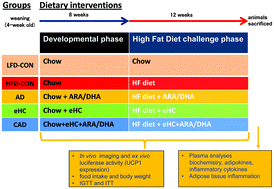当前位置:
X-MOL 学术
›
Food Funct.
›
论文详情
Our official English website, www.x-mol.net, welcomes your
feedback! (Note: you will need to create a separate account there.)
Long-chain polyunsaturated fatty acids and extensively hydrolyzed casein-induced browning in a Ucp-1 reporter mouse model of obesity†
Food & Function ( IF 5.1 ) Pub Date : 2018-03-08 00:00:00 , DOI: 10.1039/c7fo01835e Liufeng Mao 1 , Jiwen Lei , Marieke H Schoemaker , Bingxiu Ma , Yan Zhong , Tim T Lambers , Eric A F Van Tol , Yulai Zhou , Tao Nie , Donghai Wu
Food & Function ( IF 5.1 ) Pub Date : 2018-03-08 00:00:00 , DOI: 10.1039/c7fo01835e Liufeng Mao 1 , Jiwen Lei , Marieke H Schoemaker , Bingxiu Ma , Yan Zhong , Tim T Lambers , Eric A F Van Tol , Yulai Zhou , Tao Nie , Donghai Wu
Affiliation

|
Browning in adipose tissues, which can be affected by diet, may mitigate the detrimental effects of adiposity and improve longer-term metabolic health. Here, browning-inducing effects of long-chain polyunsaturated fatty acids, e.g., arachidonic acid (ARA)/docosahexaenoic acid (DHA) and extensively hydrolyzed casein (eHC) were investigated in uncoupling protein 1 (Ucp-1) reporter mice. To address the overall functionality, their potential role in supporting a healthy metabolic profile under obesogenic dietary challenges later in life was evaluated. At weaning Ucp1+/LUC reporter mice were fed a control low fat diet (LFD) with or without ARA + DHA, eHC or eHC + ARA + DHA for 8 weeks until week 12 after which interventions continued for another 12 weeks under a high-fat diet (HFD) challenge. Serology (metabolic responses and inflammation) and in vivo and ex vivo luciferase activity were determined; in the meantime browning-related proteins UCP-1 and the genes peroxisome proliferator-activated receptor gamma coactivator 1-alpha (PGC1α), PR domain containing 16 (PRDM16) and Ucp-1 were examined. ARA + DHA, eHC or their combination reduced body weight gain and adipose tissue weight compared to the HFD mice. The interventions induced Ucp-1 expression in adipose tissues prior to and during the HFD exposure. Ucp-1 induction was accompanied by higher PGC1a and PRDM16 expression. Glucose tolerance and insulin sensitivity were improved coinciding with lower serum cholesterol, triglycerides, free fatty acids, insulin, leptin, resistin, fibroblast growth factor 21, alanine aminotransferase, aspartate aminotransferase and higher adiponectin than the HFD group. HFD-associated increased systemic (IL-1β and TNF-α) and adipose tissue inflammation (F4/80, IL-1β, TNF-α, IL-6) was reduced. Studies in a Ucp-1 reporter mouse model revealed that early intervention with ARA/DHA and eHC improves metabolic flexibility and attenuates obesity during HFD challenge later in life. Increased browning is suggested as, at least, part of the underlying mechanism.
中文翻译:

Ucp-1 报告小鼠肥胖模型中长链多不饱和脂肪酸和广泛水解酪蛋白诱导的褐变†
脂肪组织的褐变可能会受到饮食的影响,可能会减轻肥胖的有害影响并改善长期代谢健康。在此,在解偶联蛋白1(Ucp-1)报告小鼠中研究了长链多不饱和脂肪酸(例如花生四烯酸(ARA)/二十二碳六烯酸(DHA)和深度水解酪蛋白(eHC))的褐变诱导作用。为了解决整体功能问题,评估了它们在晚年肥胖饮食挑战下支持健康代谢状况的潜在作用。断奶时,Ucp1 +/LUC报告小鼠被喂食对照低脂饮食(LFD),含或不含 ARA + DHA、eHC 或 eHC + ARA + DHA 8 周,直至第 12 周,此后在高饮食条件下继续干预 12 周。脂肪饮食(HFD)挑战。测定血清学(代谢反应和炎症)以及体内和离体荧光素酶活性;同时检查了褐变相关蛋白UCP-1和基因过氧化物酶体增殖物激活受体γ共激活剂1-α( PGC1α)、含有PR结构域16 (PRDM16)和Ucp-1 。与 HFD 小鼠相比,ARA + DHA、eHC 或其组合减少了体重增加和脂肪组织重量。在接触 HFD 之前和期间,干预措施诱导脂肪组织中Ucp-1 的表达。Ucp-1诱导伴随着较高的PGC1a和PRDM16表达。与 HFD 组相比,葡萄糖耐量和胰岛素敏感性得到改善,同时血清胆固醇、甘油三酯、游离脂肪酸、胰岛素、瘦素、抵抗素、成纤维细胞生长因子 21、丙氨酸转氨酶、天冬氨酸转氨酶和脂联素水平降低。HFD 相关的全身炎症(IL-1β 和 TNF-α)增加,脂肪组织炎症(F4/80、IL-1β、TNF-α、IL-6)减少。对 Ucp-1 报告小鼠模型的研究表明,早期使用 ARA/DHA 和 eHC 进行干预可以改善代谢灵活性,并减轻日后 HFD 挑战期间的肥胖。褐变的增加被认为至少是潜在机制的一部分。
更新日期:2018-03-08
中文翻译:

Ucp-1 报告小鼠肥胖模型中长链多不饱和脂肪酸和广泛水解酪蛋白诱导的褐变†
脂肪组织的褐变可能会受到饮食的影响,可能会减轻肥胖的有害影响并改善长期代谢健康。在此,在解偶联蛋白1(Ucp-1)报告小鼠中研究了长链多不饱和脂肪酸(例如花生四烯酸(ARA)/二十二碳六烯酸(DHA)和深度水解酪蛋白(eHC))的褐变诱导作用。为了解决整体功能问题,评估了它们在晚年肥胖饮食挑战下支持健康代谢状况的潜在作用。断奶时,Ucp1 +/LUC报告小鼠被喂食对照低脂饮食(LFD),含或不含 ARA + DHA、eHC 或 eHC + ARA + DHA 8 周,直至第 12 周,此后在高饮食条件下继续干预 12 周。脂肪饮食(HFD)挑战。测定血清学(代谢反应和炎症)以及体内和离体荧光素酶活性;同时检查了褐变相关蛋白UCP-1和基因过氧化物酶体增殖物激活受体γ共激活剂1-α( PGC1α)、含有PR结构域16 (PRDM16)和Ucp-1 。与 HFD 小鼠相比,ARA + DHA、eHC 或其组合减少了体重增加和脂肪组织重量。在接触 HFD 之前和期间,干预措施诱导脂肪组织中Ucp-1 的表达。Ucp-1诱导伴随着较高的PGC1a和PRDM16表达。与 HFD 组相比,葡萄糖耐量和胰岛素敏感性得到改善,同时血清胆固醇、甘油三酯、游离脂肪酸、胰岛素、瘦素、抵抗素、成纤维细胞生长因子 21、丙氨酸转氨酶、天冬氨酸转氨酶和脂联素水平降低。HFD 相关的全身炎症(IL-1β 和 TNF-α)增加,脂肪组织炎症(F4/80、IL-1β、TNF-α、IL-6)减少。对 Ucp-1 报告小鼠模型的研究表明,早期使用 ARA/DHA 和 eHC 进行干预可以改善代谢灵活性,并减轻日后 HFD 挑战期间的肥胖。褐变的增加被认为至少是潜在机制的一部分。











































 京公网安备 11010802027423号
京公网安备 11010802027423号